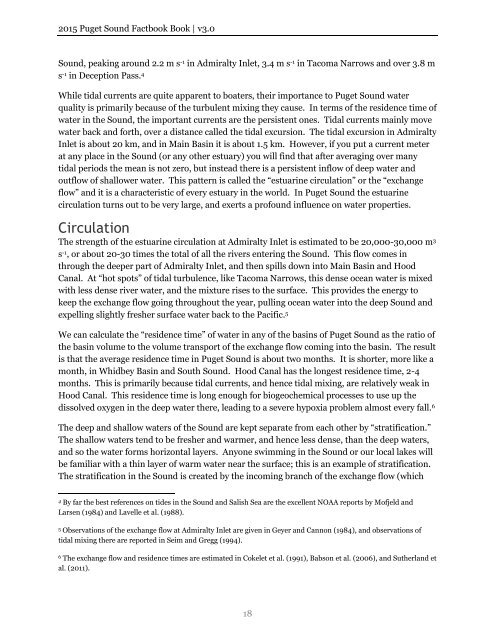Create successful ePaper yourself
Turn your PDF publications into a flip-book with our unique Google optimized e-Paper software.
2015 <strong>Puget</strong> <strong>Sound</strong> Factbook Book | v3.0<br />
<strong>Sound</strong>, peaking around 2.2 m s -1 in Admiralty Inlet, 3.4 m s -1 in Tacoma Narrows and over 3.8 m<br />
s -1 in Deception Pass. 4<br />
While tidal currents are quite apparent to boaters, <strong>the</strong>ir importance to <strong>Puget</strong> <strong>Sound</strong> water<br />
quality is primarily because of <strong>the</strong> turbulent mixing <strong>the</strong>y cause. In terms of <strong>the</strong> residence time of<br />
water in <strong>the</strong> <strong>Sound</strong>, <strong>the</strong> important currents are <strong>the</strong> persistent ones. Tidal currents mainly move<br />
water back and forth, over a distance called <strong>the</strong> tidal excursion. The tidal excursion in Admiralty<br />
Inlet is about 20 km, and in Main Basin it is about 1.5 km. However, if you put a current meter<br />
at any place in <strong>the</strong> <strong>Sound</strong> (or any o<strong>the</strong>r estuary) you will find that after averaging over many<br />
tidal periods <strong>the</strong> mean is not zero, but instead <strong>the</strong>re is a persistent inflow of deep water and<br />
outflow of shallower water. This pattern is called <strong>the</strong> “estuarine circulation” or <strong>the</strong> “exchange<br />
flow” and it is a characteristic of every estuary in <strong>the</strong> world. In <strong>Puget</strong> <strong>Sound</strong> <strong>the</strong> estuarine<br />
circulation turns out to be very large, and exerts a profound influence on water properties.<br />
Circulation<br />
The strength of <strong>the</strong> estuarine circulation at Admiralty Inlet is estimated to be 20,000-30,000 m 3<br />
s -1 , or about 20-30 times <strong>the</strong> total of all <strong>the</strong> rivers entering <strong>the</strong> <strong>Sound</strong>. This flow comes in<br />
through <strong>the</strong> deeper part of Admiralty Inlet, and <strong>the</strong>n spills down into Main Basin and Hood<br />
Canal. At “hot spots” of tidal turbulence, like Tacoma Narrows, this dense ocean water is mixed<br />
with less dense river water, and <strong>the</strong> mixture rises to <strong>the</strong> surface. This provides <strong>the</strong> energy to<br />
keep <strong>the</strong> exchange flow going throughout <strong>the</strong> year, pulling ocean water into <strong>the</strong> deep <strong>Sound</strong> and<br />
expelling slightly fresher surface water back to <strong>the</strong> Pacific. 5<br />
We can calculate <strong>the</strong> “residence time” of water in any of <strong>the</strong> basins of <strong>Puget</strong> <strong>Sound</strong> as <strong>the</strong> ratio of<br />
<strong>the</strong> basin volume to <strong>the</strong> volume transport of <strong>the</strong> exchange flow coming into <strong>the</strong> basin. The result<br />
is that <strong>the</strong> average residence time in <strong>Puget</strong> <strong>Sound</strong> is about two months. It is shorter, more like a<br />
month, in Whidbey Basin and South <strong>Sound</strong>. Hood Canal has <strong>the</strong> longest residence time, 2-4<br />
months. This is primarily because tidal currents, and hence tidal mixing, are relatively weak in<br />
Hood Canal. This residence time is long enough for biogeochemical processes to use up <strong>the</strong><br />
dissolved oxygen in <strong>the</strong> deep water <strong>the</strong>re, leading to a severe hypoxia problem almost every fall. 6<br />
The deep and shallow waters of <strong>the</strong> <strong>Sound</strong> are kept separate from each o<strong>the</strong>r by “stratification.”<br />
The shallow waters tend to be fresher and warmer, and hence less dense, than <strong>the</strong> deep waters,<br />
and so <strong>the</strong> water forms horizontal layers. Anyone swimming in <strong>the</strong> <strong>Sound</strong> or our local lakes will<br />
be familiar with a thin layer of warm water near <strong>the</strong> surface; this is an example of stratification.<br />
The stratification in <strong>the</strong> <strong>Sound</strong> is created by <strong>the</strong> incoming branch of <strong>the</strong> exchange flow (which<br />
4<br />
By far <strong>the</strong> best references on tides in <strong>the</strong> <strong>Sound</strong> and Salish Sea are <strong>the</strong> excellent NOAA reports by Mofjeld and<br />
Larsen (1984) and Lavelle et al. (1988).<br />
5<br />
Observations of <strong>the</strong> exchange flow at Admiralty Inlet are given in Geyer and Cannon (1984), and observations of<br />
tidal mixing <strong>the</strong>re are reported in Seim and Gregg (1994).<br />
6<br />
The exchange flow and residence times are estimated in Cokelet et al. (1991), Babson et al. (2006), and Su<strong>the</strong>rland et<br />
al. (2011).<br />
18


